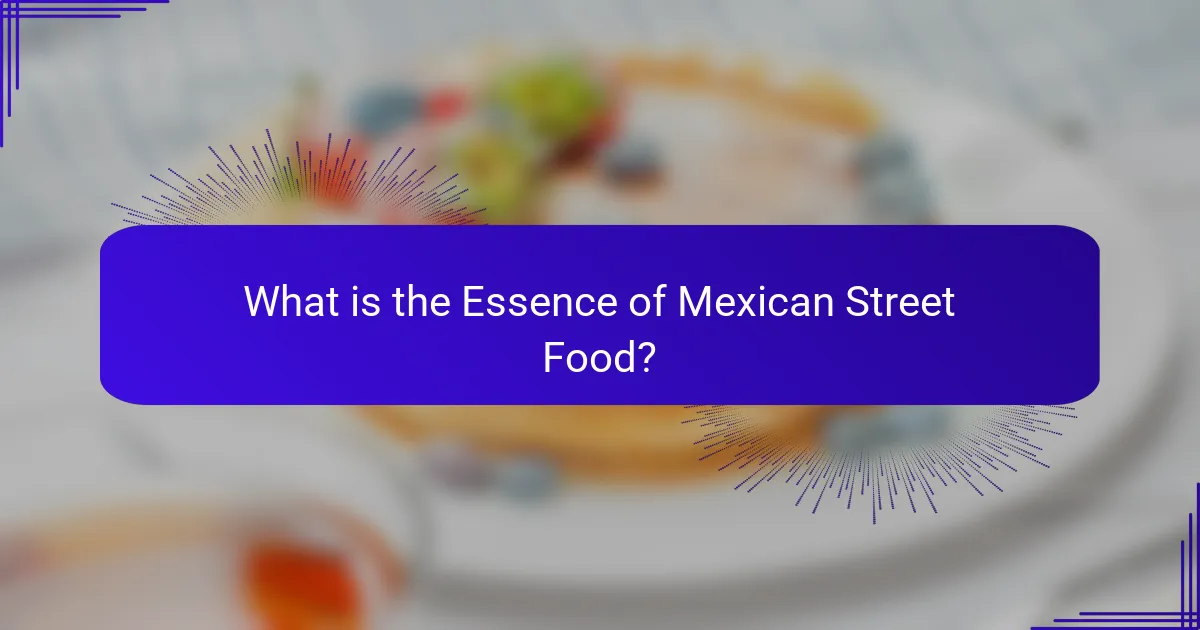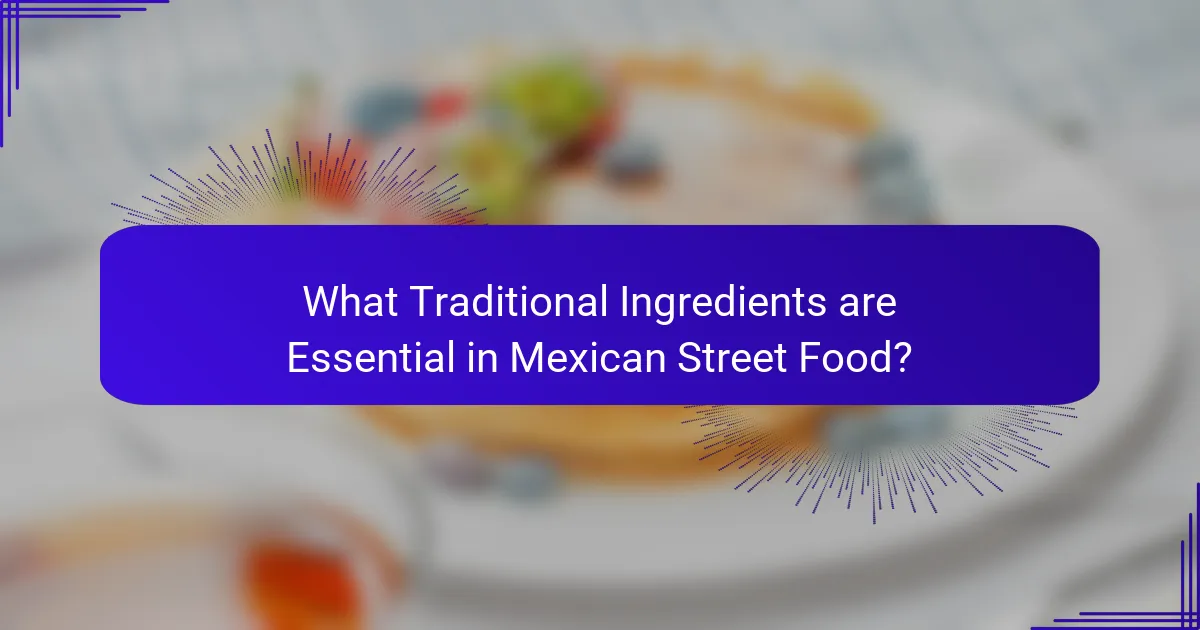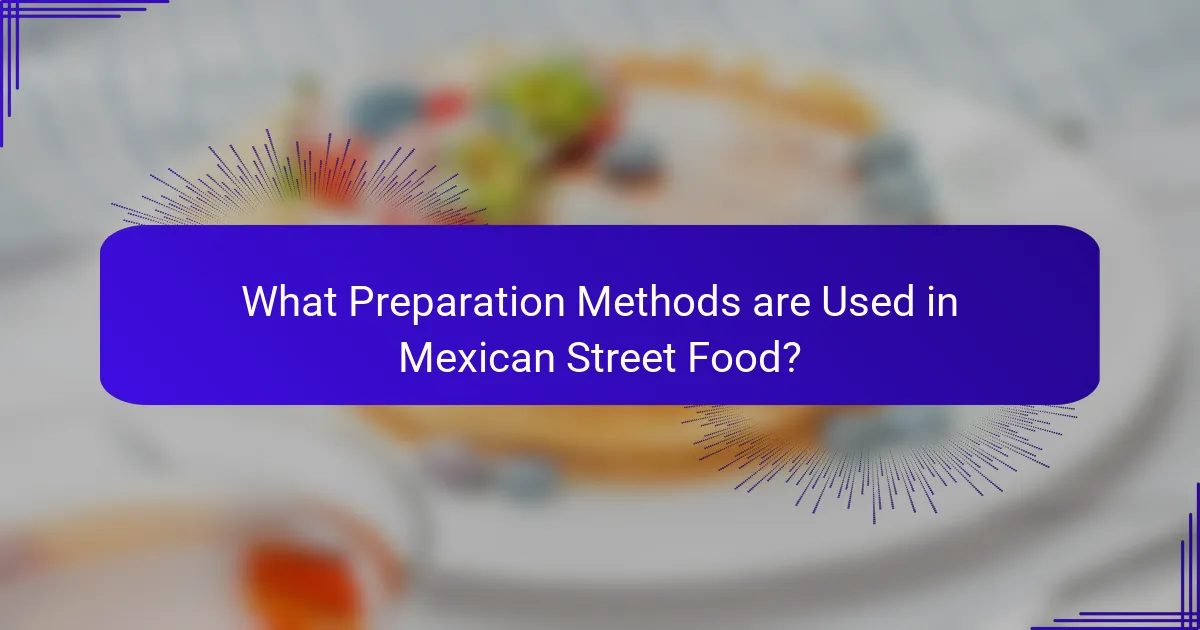
What is the Essence of Mexican Street Food?
The essence of Mexican street food lies in its vibrant flavors and cultural significance. It reflects the diversity of Mexican cuisine, incorporating local ingredients and traditional cooking methods. Street food is often made fresh and served quickly, showcasing regional specialties. Popular items include tacos, tamales, and elotes, each with unique flavors and preparation styles. The social aspect of street food culture fosters community and connection among vendors and customers. According to the Mexican government, street food represents a significant part of the national culinary identity. This cuisine is not just about sustenance; it embodies history, tradition, and the everyday life of the people.
How did Mexican street food evolve over time?
Mexican street food evolved through a blend of indigenous traditions and Spanish colonial influences. The Aztecs and Mayans originally prepared foods using local ingredients such as corn, beans, and chilies. After the Spanish conquest in the 16th century, new ingredients like meat, cheese, and spices were introduced. Street vendors began to emerge in urban areas, selling quick and affordable meals to a growing population. Over time, regional variations developed, reflecting local tastes and available ingredients. For example, tacos became popular in various forms across Mexico. Today, Mexican street food is celebrated globally for its diversity and flavor. It continues to adapt, incorporating modern culinary trends while honoring traditional practices.
What historical influences shaped Mexican street food?
Mexican street food is shaped by a blend of indigenous and colonial influences. Indigenous cultures, such as the Aztecs and Mayans, contributed staple ingredients like corn, beans, and chili peppers. The arrival of Spanish colonizers in the 16th century introduced new ingredients, including meat, dairy, and spices. This fusion led to the creation of iconic dishes, such as tacos and tamales. Over the centuries, regional variations emerged, influenced by local traditions and available ingredients. The street food culture evolved as vendors adapted traditional recipes for convenience and accessibility. Today, Mexican street food reflects a rich tapestry of history, culture, and culinary innovation.
How do regional variations impact the essence of street food?
Regional variations significantly impact the essence of street food by influencing flavors, ingredients, and preparation methods. In Mexico, for example, street food reflects local agricultural products. Coastal regions utilize seafood, while inland areas focus on meats and grains. Each region’s climate shapes the availability of fresh ingredients. Traditional recipes are adapted to incorporate local spices and cooking techniques. For instance, Oaxaca is known for its distinct moles, while Yucatán features citrus flavors. These variations create a diverse culinary landscape that represents cultural identity. Street food serves as a medium for regional storytelling and community connection.
What are the key characteristics of Mexican street food?
Mexican street food is known for its bold flavors and diverse offerings. It typically includes items like tacos, tamales, and elotes. These foods are often made with fresh, local ingredients. Common ingredients include corn, beans, and various meats. Preparation methods are usually simple and quick, allowing for fast service. Street vendors often cook food in front of customers, enhancing the experience. The food is usually served in portable formats for easy consumption. Mexican street food reflects regional variations, showcasing local tastes and traditions.
What types of flavors and textures are commonly found?
Mexican street food commonly features vibrant flavors and diverse textures. Flavors include spicy, tangy, sweet, and savory elements. Ingredients like chilies, lime, and cilantro contribute to the bold taste profile. Textures range from crispy to chewy, with items like crispy tacos and soft tamales. The combination of these flavors and textures creates a unique culinary experience. Traditional dishes often balance heat with acidity, enhancing taste complexity. For example, elote combines creamy, spicy, and smoky flavors with a crunchy texture. Overall, the interplay of flavors and textures defines Mexican street food’s appeal.
How does the presentation of street food enhance its appeal?
The presentation of street food enhances its appeal by making it visually enticing and culturally engaging. Attractive plating and vibrant colors draw attention. This visual aspect can stimulate appetite and create excitement. For example, traditional Mexican street food often features colorful toppings and garnishes. Such presentation reflects cultural heritage and culinary artistry. Studies show that visually appealing food can increase perceived taste quality. This connection between presentation and perception influences consumer choices significantly.

What Traditional Ingredients are Essential in Mexican Street Food?
Corn is a traditional ingredient essential in Mexican street food. It serves as the base for tortillas, tamales, and elotes. Tortillas are fundamental for tacos and quesadillas. They are made from masa, a dough derived from corn. Beans are another staple, providing protein and flavor. They are often served in various forms, such as refried beans or whole beans. Chiles add heat and depth to dishes. They come in many varieties, including jalapeño and poblano. Cilantro is frequently used as a garnish, offering freshness. Lime juice enhances flavors and is commonly squeezed over dishes. These ingredients reflect the rich culinary heritage of Mexico.
Which staples form the foundation of Mexican street food?
Corn, beans, and chili peppers form the foundation of Mexican street food. Corn is used to make tortillas, tamales, and elotes. Beans are often served as a side dish or filling. Chili peppers add heat and flavor to various dishes. These ingredients reflect Mexico’s agricultural heritage. They are staples in many traditional recipes. Their use in street food showcases cultural significance. The combination of these staples creates iconic flavors in dishes like tacos and quesadillas.
What role do corn and beans play in street food dishes?
Corn and beans are fundamental components of street food dishes in Mexico. They provide essential nutrients and flavors. Corn is often used to make tortillas, tamales, and elotes. These dishes are staples in Mexican cuisine. Beans serve as a protein source and are commonly found in tacos, burritos, and soups. Together, they create a balanced meal. Historically, corn and beans have been cultivated for thousands of years in Mesoamerica. Their combination is known as the “Three Sisters,” which also includes squash. This trio is vital for traditional agricultural practices. The use of corn and beans in street food reflects cultural heritage and culinary traditions.
How do herbs and spices enhance the flavors of street food?
Herbs and spices enhance the flavors of street food by adding depth and complexity. They provide distinct tastes and aromas that elevate simple ingredients. For example, cilantro adds freshness, while cumin offers warmth. These flavor profiles create a more enjoyable eating experience. Additionally, spices like chili can introduce heat, stimulating the palate. Herbs and spices also contribute to cultural identity in street food. They reflect regional traditions and culinary practices. This connection to culture enhances the overall appeal of the food.
What unique ingredients are commonly used in specific street foods?
Unique ingredients commonly used in specific Mexican street foods include corn, chilies, and beans. Corn is the foundation for dishes like tacos and tamales. It is used in various forms, such as masa for tortillas. Chilies provide distinct flavors and heat. Varieties like jalapeño and poblano are prevalent in salsas and sauces. Beans, often black or pinto, serve as a protein source in many dishes. They are frequently used in burritos and as side dishes. Additionally, unique ingredients like cactus (nopales) and cheese (queso fresco) enhance the culinary experience. Cactus is often grilled or used in salads. Cheese adds richness to tacos and quesadillas. These ingredients reflect the agricultural heritage of Mexico and the influence of indigenous cultures.
How do local ingredients vary by region?
Local ingredients vary by region due to climate, soil type, and cultural influences. For example, coastal areas of Mexico often feature seafood, while inland regions emphasize meats and grains. The Yucatán Peninsula is known for its use of achiote and citrus fruits. In contrast, the northern states utilize wheat for tortillas and bread. Additionally, regions like Oaxaca are famous for their diverse varieties of chili peppers. Each area’s unique agricultural practices shape the local cuisine. Historical trade routes also influenced ingredient availability and usage. These variations contribute to the rich diversity of Mexican street food.
What are some lesser-known ingredients that add authenticity?
Lesser-known ingredients that add authenticity to Mexican street food include epazote, hoja santa, and xoconostle. Epazote is a pungent herb often used in beans and moles. It has historical roots in indigenous cooking, enhancing flavors and aiding digestion. Hoja santa, known as “sacred leaf,” adds a unique anise flavor to dishes like tamales and soups. Its use dates back to ancient Mesoamerican cultures. Xoconostle, a sour cactus fruit, is used in salsas and stews. It provides a distinctive tartness and is rich in nutrients. These ingredients contribute to the rich tapestry of flavors in traditional Mexican cuisine.

What Preparation Methods are Used in Mexican Street Food?
Mexican street food is prepared using various methods, including grilling, frying, and steaming. Grilling imparts a smoky flavor, often seen in tacos al pastor. Frying is common for snacks like churros and quesadillas, creating a crispy texture. Steaming is utilized for tamales, which are made from masa and filled with various ingredients. Roasting is another method, frequently used for vegetables and meats, enhancing their natural flavors. Each technique contributes to the unique taste and texture of the dishes. These methods reflect traditional practices that have been passed down through generations in Mexican cuisine.
How do traditional cooking techniques influence street food?
Traditional cooking techniques significantly influence street food by preserving cultural flavors and methods. Techniques such as roasting, grilling, and frying are commonly used in street food preparation. These methods enhance the taste and texture of ingredients. For example, the use of comales for tortilla making is a traditional technique that adds authenticity to tacos. Additionally, slow-cooking methods like braising are often employed for meats, resulting in rich flavors. The influence of these techniques can be traced back to indigenous practices. They have been passed down through generations, maintaining culinary heritage. Street food vendors often adapt these methods to local tastes and available ingredients. This fusion creates unique dishes that reflect regional identities.
What methods are commonly used for grilling and frying?
Common methods for grilling include direct heat grilling and indirect heat grilling. Direct heat grilling exposes food to flames or hot coals. This method is ideal for quick-cooking foods like vegetables and thin cuts of meat. Indirect heat grilling involves cooking food beside the heat source, suitable for larger cuts that require longer cooking times.
Frying methods include deep frying and pan frying. Deep frying submerges food in hot oil, creating a crispy exterior. This method is commonly used for items like churros and tortilla chips. Pan frying uses a smaller amount of oil, cooking food in a skillet over medium heat. This method is often used for preparing tacos and quesadillas.
How does the use of street-side cooking equipment affect flavor?
The use of street-side cooking equipment enhances flavor through direct heat and smoke infusion. Grills, comales, and open flames create a unique char and depth. This equipment allows for high-temperature cooking, which caramelizes sugars and intensifies flavors. The materials used, such as cast iron or clay, also contribute to flavor profiles. For example, a comal imparts a distinct taste to tortillas. Additionally, the outdoor environment adds subtle nuances from wood smoke. These factors combine to create authentic and rich flavors characteristic of Mexican street food.
What modern adaptations have emerged in preparation methods?
Modern adaptations in preparation methods of Mexican street food include the use of sous-vide cooking and air frying. Sous-vide allows for precise temperature control, enhancing flavor and texture. Air frying reduces oil usage while maintaining crispiness in traditional fried foods. Additionally, food trucks have emerged as mobile kitchens, providing accessibility and variety. Digital platforms now facilitate online ordering, streamlining the customer experience. These methods reflect a blend of tradition and innovation in contemporary culinary practices.
How have health trends influenced cooking techniques?
Health trends have significantly influenced cooking techniques by promoting healthier methods of food preparation. For example, there is a growing preference for grilling, steaming, and baking over frying. These techniques reduce fat content in dishes, aligning with health-conscious diets. Additionally, the use of fresh, whole ingredients has increased, leading to a decline in processed foods. This shift supports the emphasis on nutrition and natural flavors. Furthermore, the rise of plant-based diets has encouraged techniques like sautéing vegetables and using legumes as protein sources. These changes reflect a broader awareness of health and wellness in culinary practices.
What innovations are being introduced in street food preparation?
Innovations in street food preparation include the use of technology and modern cooking techniques. Food trucks are increasingly utilizing mobile apps for ordering and payment. This enhances customer convenience and streamlines service. Advanced cooking equipment, such as induction cookers, improves efficiency and safety. Additionally, some vendors are adopting sous-vide cooking methods for precise food preparation. This technique ensures consistent quality and flavor. Sustainable practices are also being integrated, like using biodegradable packaging. These innovations reflect a shift towards healthier and more environmentally friendly street food options.
How does Mexican street food reflect cultural significance?
Mexican street food reflects cultural significance through its diverse flavors and regional variations. It embodies the history and traditions of Mexico, showcasing local ingredients and cooking techniques. Street vendors often serve dishes that have been passed down through generations. For instance, tacos and tamales are staples that represent regional identities. The communal aspect of street food fosters social interactions and gatherings. Festivals and celebrations frequently feature street food, highlighting its role in cultural expressions. Additionally, the accessibility of street food makes it a vital part of everyday life for many Mexicans. This culinary tradition is recognized globally, contributing to the cultural pride of Mexico.
What role does street food play in community gatherings?
Street food plays a vital role in community gatherings by fostering social interactions. It serves as a communal dining experience, bringing people together. Street food vendors often create a lively atmosphere, attracting crowds. This environment encourages conversations and connections among attendees. Additionally, street food reflects local culture and traditions. It showcases regional ingredients and culinary practices. Events featuring street food often highlight community identity and pride. Overall, street food enhances the vibrancy and inclusivity of community gatherings.
How does street food contribute to cultural identity?
Street food contributes to cultural identity by reflecting local traditions and culinary practices. It serves as a medium for cultural expression and community bonding. In Mexico, street food showcases regional ingredients and recipes passed down through generations. Popular items like tacos and tamales highlight indigenous influences and Spanish colonization. Street vendors often become cultural icons, preserving and promoting local heritage. The vibrant atmosphere of street food markets fosters social interactions and strengthens community ties. Events celebrating street food further enhance cultural pride and awareness.
What are some tips for enjoying authentic Mexican street food?
To enjoy authentic Mexican street food, prioritize visiting busy food stalls. Popular stalls often indicate quality and freshness. Choose dishes that are freshly prepared in front of you. This ensures the food is hot and flavorful. Look for local favorites like tacos, tamales, and elote. These items are staples in Mexican street cuisine. Pay attention to hygiene practices at the vendor’s stall. Clean preparation areas suggest better food safety. Engage with the vendor to learn about the ingredients and preparation methods. This adds to the cultural experience. Lastly, be adventurous and try new flavors. Authentic street food offers a unique taste of Mexican culinary traditions.
How can you identify quality street food vendors?
To identify quality street food vendors, look for cleanliness and food safety practices. Vendors should maintain clean cooking areas and utensils. Observe the freshness of ingredients used in their dishes. High-quality vendors often source local produce and meats. A long line of customers typically indicates popularity and trustworthiness. Check for positive reviews on food safety and taste from previous customers. Vendors with a consistent presence in a community often build a reputation for quality. Lastly, see if they have proper permits and licenses, which signifies compliance with health regulations.
What should you know about hygiene and safety when eating street food?
When eating street food, prioritize hygiene and safety to avoid foodborne illnesses. Choose vendors with clean cooking areas and visible food preparation. Observe if the food is cooked thoroughly and served hot. Ensure that the vendor uses gloves or utensils to handle food. Avoid raw or undercooked items, especially meats and seafood. Drink bottled or boiled water to prevent contamination. Check for proper food storage and sanitation practices. According to the World Health Organization, foodborne diseases affect millions globally, emphasizing the importance of safe food handling.
The main entity of this article is Mexican street food, which encompasses traditional ingredients, preparation methods, and cultural significance. The article explores the vibrant flavors and diverse offerings of Mexican street food, highlighting key components such as corn, beans, and chilies, along with their historical evolution influenced by indigenous and colonial practices. It details various preparation methods, including grilling and frying, and discusses the role of regional variations in shaping culinary identity. Additionally, the article emphasizes the social aspect of street food culture and its importance in community gatherings, providing tips for enjoying authentic experiences while ensuring hygiene and safety.
